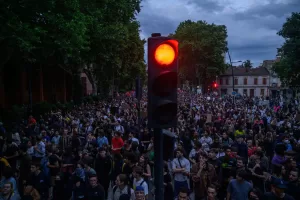Thomas Riggins
Editor’s note: This article offers important early 20th-century Marxist analysis and reflects the cultural criticism of the times.
Christopher Caudwell, the British Marxist who was killed in 1937 in the Spanish Civil War at age 29, was one of the most important cultural theorists of the past century. Many Marxists, especially of the younger generation, may never have heard of him since with the overthrow of the Soviet Union and its East European allies the entire cultural legacy of the Marxist movement has been over-shadowed by capitalist triumphalism.
One of the functions of Marxists is to keep alive the memory and the traditions of the truly great Marxist thinkers who have preceded us and whose achievements we will be the custodians of until the world revolutionary movement is again in a position to challenge the imperialist powers and block their domination of the planet. A time we are approaching more rapidly than many suspect.
Caudwell’s most important work was the posthumously published Illusion and Reality: A Study in the Sources of Poetry (1937). This article will attempt to present some of his major ideas to a contemporary audience.
According to Caudwell, the social consciousness of human beings is directly proportional to the interaction it has with other human beings and with nature. In other words, the more interaction humans have with one another and nature, the greater their social consciousness. This social consciousness is the tool used to attain freedom, which Caudwell defined as the degree of control over the environment both social and natural.
Considering the environmental damage to nature caused by capitalism and those who put profit making or “development” as the first priority with respect to the natural environment, we need to interpret Caudwell’s position as meaning our positive interactions with the natural environment with respect to preserving it and renewing it for future generations as well, not simply trying to “control” it—it is a false social consciousness that both damages nature and decreases our freedom.
Poetry had its origins in the way humanity first struggled to attain freedom. The earliest humans could not rely on a purely instinctual life such as we find in other animals. Humans had to form some type of economic cooperation (hunting, fishing, food gathering) which necessitated a higher degree of socialization of the instincts (that is, of common feelings and emotional responses) directed to group survival.
As an example, Caudwell points to the role of art in relation to early harvest festivals. The festival functions to collectivize group emotions and direct them towards the future harvest (or hunt). It does this by means of dance and ritual. Early people thus entered a world of illusion in which group goals were reinforced to bring about the socially necessary labor needed to translate the illusion into the reality of the future hunt or harvest. Caudwell believed that art was basically economic in origin and function. The individual is socialized by participation in group ceremonials—i.e., she is educated.
The development of class society breaks down the old collectivity and the artist becomes differentiated from the group. Individual artists replace group art. Art is divorced from the nitty-gritty of everyday economic concerns. In poetry, the lyric replaces the epic. While Homer reflected the collective life of Greece, the lyric poets expressed individual and solitary views of their subject matter.
So poetry, and art in general, is “the nascent self-consciousness” of humanity. A Hegelian notion better expressed by Marx as a historically determinate species-being consciousness (Economic and Philosophical Manuscripts). In other words, art brings about the beginnings of human self consciousness.
What is the content of early art? What does it reflect and create? What is its role? Its content is not an independent objective (physical) reality but social reality. Its function is to direct individual emotions to a common goal. Its role is to domesticate the instincts—to socialize them to group values. The “fantasy of poetry is a social image.”
Originally, thought separated from practice to be a “guide to action,” but gradually the guiding group became dominant in the society. This group no longer reflects a socially undifferentiated consciousness. It has become a ruling class. Two cultures now develop: the culture representing the ruling circles and “folk” culture. This is the origin of our distinction between highbrow and lowbrow culture.
Having dealt with the origins of art (poetry), Caudwell turns his attention to modern poetry. “Modern poetry is capitalist poetry.” Why do Shakespeare, Galileo, Michelangelo, Pope, Goethe, and Voltaire seem modern when compared to Valery, Cezanne, Joyce, Bergson, and Einstein, while Homer, Thales, Chaucer, and Beowulf seem remote and foreign to us?
Caudwell thinks it is because the economic base of developing capitalism which the first group represents (the bourgeois foundation) is reflected in their works. They are spokesmen of their times when the feudal worldview was under attack by a new economic class whose outlook they reflected. To the extent our culture still rests on this foundation we can identify with these thinkers and artists.
Recalling the social function of art, Caudwell points out that in class society art has separated itself from religion “as the art of a ruling class” and tends to be conservative, “academic,” and conventional. We see long periods of time, even centuries, of unchanging artistic standards (Greece, Rome, Egypt, India, China, etc.), yet the art of our time is constantly changing and seems to progress. New and radical schools of art flourish, peak, decline, and make way for new schools and experimental methods. How can this be reconciled with Caudwell’s thesis?
To answer this we must grasp the “basic contradiction of bourgeois society”—the bourgeois concept of freedom—the basic bourgeois illusion. With the overthrow of feudalism arose the idea of an aristocracy of merit (Jefferson) rather than birth. Every person is free to own private property and to dispose of her life as she wishes (originally this applied only to men). The bourgeois state appears to function above society and class as a referee between the various component parts of the population.
The basic contradiction is that,
seen from the viewpoint of the bourgeois, bourgeois society is a free society whose freedom is due to its completely free market and its absence of direct social relations, of which absence the free market is the cause and expression. But to the rest of society bourgeois society is a coercive society whose individualism and free market is the method of coercion.
The worker must enter the capitalist’s market or starve.
The basic precondition for capitalism’s advancement is its constantly revolutionizing its means of production and the concomitant competition between capitalists. The growth of monopolies takes its toll on small and medium businesses, and sometimes even giant corporations, which fail and are eliminated from the scene.
Modern art, as a product of this constantly changing society, is not conservative and conventional precisely because the bourgeois mode of production is also non-conservative and non-conventional. The bourgeois falls victim to his own system, his illusion of freedom will not save him from the exigencies of the real economic functioning of his market. “The bourgeois is always talking about liberty because it is always slipping from his grasp.” Kafka is an example of this petty bourgeois feeling of powerlessness.
Freedom from natural necessity (want) is the sine qua non for the development of spiritual freedom. Insofar as the bourgeois economy is expanding and developing, freedom from nature is growing, in the sense that our positive scientific understanding of nature allows us to work with nature to our advantage, e.g., boiling water kills germs and prevents diseases and frees us from many natural water-borne illnesses. Unfortunately, this freedom gravitates to the pole of the bourgeoisie, leaving society as a whole less and less free. Caudwell has in mind that the ruling class benefits from these developments more than the poor or the working people who may be living in unsanitary conditions or in economically adverse positions and do not benefit as much from scientific advances or social improvements.
Thus the bourgeois illusion regarding freedom, which counterpoises freedom and individualism to determinism and society, overlooks the fact that society is the instrument whereby man, the unfree individual, in association realizes his freedom and that the conditions of such association are the conditions of freedom.
This is to say that society and the collective works of humanity, not isolated individual geniuses, are the real sources by which unfree individuals come together and produce groups that increase the freedom of all.
Poetry (and art in general) in the bourgeois period functions to reinforce emotional attitudes having survival value in bourgeois society. The greater degree of complexity in modern society explains why different and contradictory artistic movements clash and contend, appealing to different classes and strata. The function of poetry (art) is to adapt the instincts to the social situation humans find themselves in or are in the act of creating.
Caudwell notes:
The bourgeois sees men’s instincts—his heart, source of his desires and aims—as the source of his freedom. This is false in as much as the instincts unadapted are blind and unfree. But when adapted by the relations of society they give rise to emotions, and the adaptations of which the emotions are the expression and mirror, are the means whereby the instinctive energy of man is diverted to drive the machine of society: the machine of society, revolving, enables man to face nature and struggle with her, not as individual instinctive man but as associated, adapted men. Thus the instincts drive on the movement which secures man’s freedom.
Art is an attempt to achieve freedom in the world of feelings and emotions. Science is that same attempt in the world of sense perceptions. There are, therefore, two methods for attaining freedom—one adapted to our inner, the other to our outer reality. To understand these, we must look to the function of the “word.”
Words “are tied to precepts which are photographic memory—images of bits of reality.” Precepts are used to create concepts, language, and the possibility of communication. For humans to be able to work together they must have a common perceptual reality changeable by their actions. The world created by language and the word gives us the Common Perceptual World. The other world, of the ego and the emotions (called by Caudwell “feeling tones”), is the Common Affective World. Cooperation and the associated life of humans in groups, interacting with and working upon nature, creates a special ego or mind so that individuals share feeling tones just as they share the meanings of words.
Science has created a “Mock Ego,” a universal observer who could create and verify the laws of science—the “any right thinking person” to whom the scientist could appeal for procedural verification. Parallel to the “Mock Ego” of science we find an equivalent for the world of art to which feeling tones and emotions can be attributed. Just as the Mock Ego of science tries to integrate the laws of objective external reality, the Mock Ego of art tries to integrate the feeling tones and emotions of associated humans. They both arise from the social interaction of humans, and they both aim at freedom—freedom from want as well as the positive freedoms of individual development and expression.
While science gives humanity more control over external reality, “the other world of art, of organized emotion attached to experience, the world of the social ego that endures all and enjoys all and by its experience organizes all, makes available for the individual a whole universe of inner freedom and desire.” One way art does this is to make the emotional content of consciousness congruent with common social aims required for the attainment of the instinctual desire for freedom and development. “Art is the consciousness of the necessity of the instincts.”
Art and science, then, are the products of the human struggle against nature. Art represents the struggle to socialize the instincts and to be free from their blind operation. Caudwell sees both science and art originating in, and then freeing themselves from, religion. Once they have independently established themselves, “religion no longer plays a useful role.”
The two conditions that a work of art must fulfill if it is to live up to its function of integrating the individual ego into the social ego are 1) that the work must be important in dealing with the crucial problems of its age as significant emotional attitudes, and 2) the work must be general—that is, the average individual must be able to relate her inchoate emotional attitudes to it in such a way that it helps her to organize them in a way beneficial to her participation in, or understanding of, the social ego.
Because of these two conditions, only a materialist outlook will enable us to come to an understanding of art—that is, the understanding of the connection between the social relations and their influences upon works of art. Art “lives in the social world and can only be of value in integrating experiences general to men, it is plain that the art of any age can only express the general experiences of men in that age.”
Art is subjective and linked to the source of our emotional self-awareness. Caudwell calls this source the “genotype.” He writes, “Art cannot escape its close relation with the genotype whose secret desires link in one endless series all human culture.” He views the genotype under two headings—the “timeless” (universal) and the “timefull” (particular).
The universal aspect leads to the following comment:
On the whole the genotype is substantially constant in all societies and all men. There is a substratum of likeness. Man does not change from Athenian to Ancient Briton and then to Londoner by innate differences stamped in by natural selection, but by acquired changes derived from social evolution.
Under the other aspect we see the timefull or particular. Caudwell holds that individual differences appear within the basic universal genotype due to a genetic “shuffle.” Thus individual differences arise, personalities, characters, etc. On the basis of these observations, Caudwell maintains that poetry represents the universal while the novel represents the individual aspect of the genotype.
Poetry helps us to adapt to the objective world surrounding us. It “is an emotional attitude towards the world.” Because it adapts our emotions to external reality, it enriches that reality. The poet gives emotional significance to the contents of the world—to a part of external reality.
In life this piece of external reality is devoid of emotional tone, but described in those particular words, and no others, it suddenly and magically shimmers with affective coloring. This affective coloring represents an emotional organization similar to that which the poet himself faced (in phantasy or actuality) with that piece of external reality.
Poetry expands with the development of society, and new poets arise from whom we demand a new emotional attitude towards our changing social reality. Great poems are those which gather the greatest amounts of the new social realities and place the proper emotional responses on them. Thus Caudwell thinks great poems must necessarily be long ones (to cover the greatest amount of new content and emotional response).
The purpose of the poem, however, is not to display its content but the emotional structure which the poem organizes and directs towards that self-same content. Poetry is just as essential as science in humanity’s attempt to interact with nature and make for itself a human world in which to live.
Poetry is the weapon of the genotype in its ongoing interactions with nature—”to mold necessity to its own likeness.” Poetry is especially important for materialists insofar as humanity and its longings can be easily overlooked in the scientific descriptions of the world in which everything is ultimately reduced to atoms, waves, energy particles, etc. “Poetry restores life and value to matter, and puts back the genotype into the world from which it was banished.”
According to Maynard Solomon (Marxism and Art), we have in Caudwell the first attempt to create a complete theory of poetry based on Marxism. He was the first Marxist to point out that fantasy plays a major role in bringing about causal changes in both human consciousness and history, and that through fantasy art changes the world by means of individual works of art whose production, by forcing into consciousness previously unarticulated and mute feelings, changes both the artist and the audience. Examples of this may found in the works of Brecht’s “dialectical theatre,” which attempts to engage individually with the members of the audience to elicit reactions involving a change of perspective and a greater understanding of reality, especially political reality. Life artistic performance is especially illustrative of the kind of art Solomon has in mind.
These insights, according to Solomon, also helped Caudwell explain the enduring appeal of the great art of the past which persists because it expresses, in addition to its historically specific emotional articulations, certain basic and common genotypical features which are universal in the human species.
This answer to the problem of how the art of one era could appeal to people in another era based on a different economic and class system (a problem raised by Marx in the introduction to his Critique of Political Economy) was another of Caudwell’s contributions to the philosophy of Marxism.
For our own times, we should ask ourselves what kind of “feeling tones” do current works of art produce. When we evaluate the movies, theatre, music, painting, architecture, and contemporary literature, especially poetry, we must analyze our immediate emotional responses. Do these works inspire us to collectively work together to overcome the problems of life and society or to resign ourselves to the status quo of the “human condition”?
In understanding our own responses, and the responses produced in others, to the emotional content of the contemporary art world we can creatively apply Caudwell’s theories to the construction of a contemporary Marxist understanding of the role and function of art.




